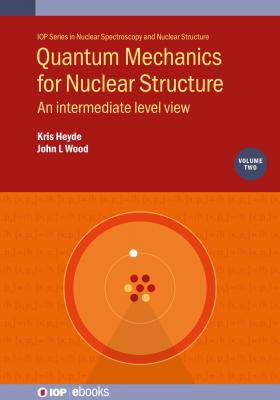Quantum Mechanics for Nuclear Structure, Volume 2. Professor Kris Heyde
Чтение книги онлайн.
Читать онлайн книгу Quantum Mechanics for Nuclear Structure, Volume 2 - Professor Kris Heyde страница 3
 5.11 The unitary and orthogonal groups in n dimensions, U(n) and SO(n)
5.11 The unitary and orthogonal groups in n dimensions, U(n) and SO(n)
5.12 Casimir invariants and commuting operators
5.12.1 The Casimir invariants of u(n)
5.12.2 The Casimir invariants of so(n)
6 Algebraic structure of quantum mechanics
6.1 Angular momentum theory as an application of a Lie algebra
6.2 The Lie algebra su(1,1) ∼ sp(1,R)
6.3.1 su(3) and the isotropic harmonic oscillator in three dimensions
6.3.2 so(4) and the hydrogen atom (Kepler problem)
6.4 so(5) and models with ‘quadrupole’ degrees of freedom (Bohr model)
6.5 The Lie algebra sp(3,R) and microscopic models of nuclear collectivity
6.6.1 SU(3) tensor tableau calculus
6.6.2 Multiplicity of a weight state in an SU(3) irrep
6.6.3 Dimension of an SU(3) irrep: Robinson ‘hook-length’ method (figure 6.8)
6.6.4 SU(2) irreps contained in an SU(3) irrep
6.7 Introduction to Cartan theory of Lie algebras
6.7.1 Cartan structure of the so(4) Lie algebra
6.7.2 Cartan structure of the su(3) Lie algebra
6.7.4 Irrep quantum numbers: Cartan subalgebras and Casimir operators
7 Perturbation theory and the variational method
7.1 Time-independent perturbation theory
7.2 Time-independent perturbation theory for systems with degeneracy
7.3 An example of (second-order) degenerate perturbation theory
7.4 Perturbation theory and symmetry
8 Time-dependent perturbation theory
8.2 Time-dependent perturbation theory
8.3 Constant perturbations and Fermi’s golden rule
9 Electromagnetic fields in quantum mechanics
9.1 The quantization of the electromagnetic field
9.2 The interaction of the electromagnetic field with matter
9.3 The emission and absorption of photons by atoms
10 Epilogue
Appendix A
Appendix B
Preface
This book, the second in a two-part work, deals with topics that are essential for a mastery of the quantum mechanics underlying the nuclear many-body problem. These topics represent what can fairly be described as ‘an intermediate level view’, and so we adopted this subtitle. There are also some more specialised topics that we have selected because it is our opinion that they are important for handling the emerging view of the quantum mechanics needed to understand nuclei.
We begin with a thorough treatment of angular momentum theory, handled in three chapters. First, we present representations of rotations, angular momentum, and spin. This is manifested in all of their popular guises;